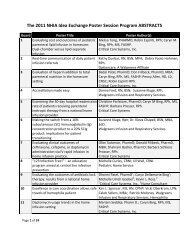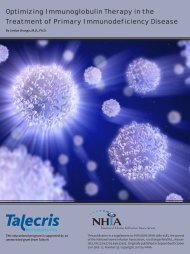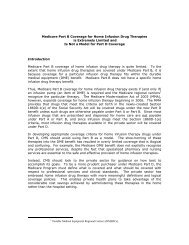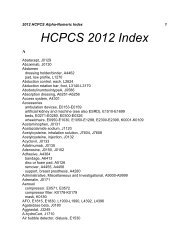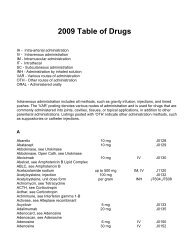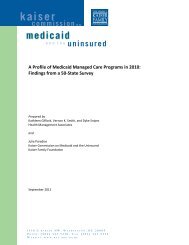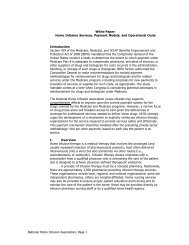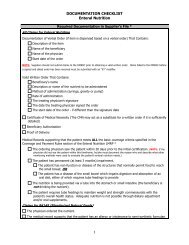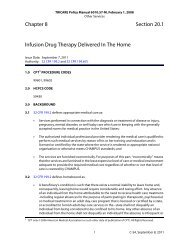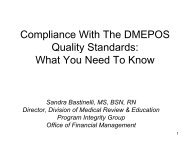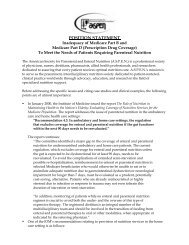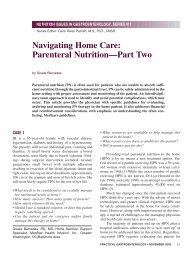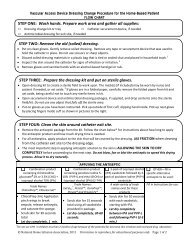IgG Therapy for the Home-Based Patient: Administration and ... - NHIA
IgG Therapy for the Home-Based Patient: Administration and ... - NHIA
IgG Therapy for the Home-Based Patient: Administration and ... - NHIA
You also want an ePaper? Increase the reach of your titles
YUMPU automatically turns print PDFs into web optimized ePapers that Google loves.
<strong>IgG</strong> <strong>Therapy</strong> <strong>for</strong> <strong>the</strong> <strong>Home</strong>-<strong>Based</strong> <strong>Patient</strong>: <strong>Administration</strong><br />
<strong>and</strong> Delivery Method Considerations<br />
By Hetty Lima, R.Ph., FASHP, <strong>and</strong> Amy Clarke, R.N.<br />
Adapted from <strong>the</strong> original April 26 presentation at <strong>the</strong> 2012 <strong>NHIA</strong> Annual Conference & Exposition<br />
Supported by an educational grant from CSL Behring
CE In<strong>for</strong>mation:<br />
Pharmacist<br />
This INFUSION article is cosponsored by Educational Review Systems (ERS), which is accredited by <strong>the</strong> Accreditation<br />
Council <strong>for</strong> Pharmacy Education (ACPE) as a provider of continuing pharmacy education. ERS has assigned<br />
1 contact hour (0.1 CEU) of continuing education credits to this article. Eligibility to receive continuing education<br />
credits <strong>for</strong> this article begins December 1, 2012 <strong>and</strong> expires November 20, 2015. The universal activity number<br />
<strong>for</strong> this program is 0761999912176H01P. Activity Type: Knowledge<strong>Based</strong>.<br />
Dietitian<br />
CPE<br />
Accredited<br />
Provider<br />
Educational Review Systems (Provider number ED002) is a Continuing Professional Education (CPE)<br />
Accredited Provider with <strong>the</strong> Commission on Dietetic Registration (CDR). Registered dietitians (RDs) <strong>and</strong><br />
dietetic technicians, registered (DTRs) will receive 1 hour or 1 continuing professional education unit (CPEU)<br />
<strong>for</strong> completion of this program/material. Eligibility to receive continuing education credits <strong>for</strong> this article<br />
begins December 1, 2012 <strong>and</strong> expires November 30, 2014.<br />
Nurse<br />
Educational Review Systems is an approved provider of continuing nursing education by Alabama State<br />
Nurses Association (ASNA), an accredited approver of continuing nursing education by <strong>the</strong> American<br />
Nurses Credentialing Center, Commission on Accreditation. Program # 0511512002.<br />
This program is approved <strong>for</strong> 1 hour of continuing nursing education. Eligibility to receive continuing education credits <strong>for</strong> this<br />
article begins December 1, 2012 <strong>and</strong> expires November 30, 2014. Educational Review Systems is also approved <strong>for</strong> nursing continuing<br />
education by <strong>the</strong> state of Cali<strong>for</strong>nia, <strong>the</strong> state of Florida, <strong>and</strong> <strong>the</strong> District of Columbia.<br />
This continuing education article is intended <strong>for</strong> pharmacists, nurses, dietitians, <strong>and</strong> o<strong>the</strong>r alternatesite infusion professionals. In<br />
order to receive credit <strong>for</strong> this program activity, participants must complete <strong>the</strong> online posttest <strong>and</strong> subsequent evaluation questions<br />
available at this link: www.nhia.org/CE_Infusion. Participants are allowed two attempts to receive a minimum passing score<br />
of 70%.<br />
Approval as a provider refers to recognition of educational activities only <strong>and</strong> does not imply Accreditation Council <strong>for</strong> Pharmacy<br />
Education, ERS, ANCC Commission on Accreditation, or Commission on Dietetic Registration approval or endorsement<br />
of any product.<br />
Educational Learning Objectives:<br />
After reading this article, <strong>the</strong> participant should be able to:<br />
1. Distinguish between <strong>the</strong> advantages <strong>and</strong> disadvantages of SCIG <strong>for</strong> homebased patients.<br />
2. Explain <strong>the</strong> differences in bioavailability <strong>and</strong> dosing strategy <strong>for</strong> IVIG versus SCIG.<br />
3. Describe <strong>the</strong> role of monitoring outcomes such as disease progression, frequency of infection, <strong>and</strong> days of school/work<br />
missed in clinical decision making.<br />
4. Enumerate <strong>the</strong> core elements of patient <strong>and</strong> caregiver education when transitioning a patient to self administration of<br />
SCIG <strong>the</strong>rapy.<br />
<strong>IgG</strong> <strong>Therapy</strong> <strong>for</strong> <strong>the</strong> <strong>Home</strong><strong>Based</strong> <strong>Patient</strong>: <strong>Administration</strong> <strong>and</strong> Delivery Method Considerations
Author Bios:<br />
Hetty Lima, R.Ph., FASHP, is <strong>the</strong> Vice President of Specialty Infusion<br />
<strong>and</strong> Rare Diseases at Diplomat Specialty Pharmacy in Flint,<br />
Michigan. An accomplished health care executive with more<br />
than 27 years of home infusion/specialty pharmacy experience,<br />
she has held executive leadership positions at providers such as<br />
Baxter Healthcare, CVS/Caremark’s Specialty Pharmacy division,<br />
<strong>and</strong> Coram’s Hemophilia Services division. A graduate of <strong>the</strong> University<br />
of Rhode Isl<strong>and</strong>, Lima is also <strong>the</strong> past President of <strong>the</strong><br />
American Society of HealthSystem Pharmacists’ (ASHP’s) Section<br />
of <strong>Home</strong> Care Practitioners. She has lectured at national <strong>and</strong><br />
international pharmacy <strong>and</strong> nursing meetings <strong>and</strong> has published<br />
extensively on <strong>the</strong> clinical <strong>and</strong> practical aspects of home infusion<br />
<strong>and</strong> specialty pharmacy. Her work has appeared in numerous<br />
pharmacy <strong>and</strong> nursing journals <strong>and</strong> pharmaceutical texts.<br />
Amy Clarke, R.N., is a registered nurse <strong>and</strong> has practiced in <strong>the</strong><br />
home infusion arena since 1994, as Director of Nursing <strong>for</strong> <strong>the</strong><br />
Chicago locations of Chartwell Diversified Services <strong>and</strong> Option<br />
Care’s <strong>Home</strong> Infusion <strong>Therapy</strong> Pharmacies. Clarke has provided clinical<br />
education on infusion <strong>the</strong>rapy <strong>and</strong> specialty medications to<br />
nursing staff (internal <strong>and</strong> external), pharmacists, physicians, <strong>and</strong><br />
social workers. She has presented continuing education presentations<br />
to some of <strong>the</strong> nation’s top payers including various Blue<br />
Cross Blue Shield plans, Humana, Aetna <strong>and</strong> United Healthcare.<br />
Clarke has a particular passion <strong>for</strong> immunoglobulin <strong>the</strong>rapy, having<br />
personally per<strong>for</strong>med over 1,500 IV <strong>and</strong> SC infusions to date.<br />
Working with home infusion pharmacy in <strong>the</strong> 1990s she observed<br />
that IVIG was not well understood by nursing staff, pharmacies,<br />
payers, <strong>and</strong> in many instances <strong>the</strong> physicians <strong>the</strong>mselves. She has<br />
developed multiple presentations on IVIG administration<br />
specifics, as well as <strong>the</strong> “ins <strong>and</strong> outs” of subcutaneous IG <strong>the</strong>rapy.<br />
Clarke has developed a successful national <strong>IgG</strong> program as<br />
Program Manager <strong>for</strong> Diplomat Specialty Pharmacy.<br />
AUTHOR DISCLOSURE STATEMENT:<br />
The authors declare no conflicts of interest or financial interest<br />
in any product or service mentioned in this program,<br />
including grants, employment, gifts, stock<br />
holdings, <strong>and</strong> honoraria. This article may include discussion<br />
of offlabel/investigational drug use but in a fair <strong>and</strong><br />
unbiased manner. Hetty Lima <strong>and</strong> her sons use medications<br />
from <strong>the</strong> sponsoring organization (CSL Behring) to<br />
treat Von Willebr<strong>and</strong>’s Disease.<br />
<strong>IgG</strong> <strong>Therapy</strong> <strong>for</strong> <strong>the</strong> <strong>Home</strong><strong>Based</strong> <strong>Patient</strong>: <strong>Administration</strong> <strong>and</strong> Delivery Method Considerations 1
<strong>IgG</strong> Market Overview <strong>and</strong> Uses<br />
The <strong>IgG</strong> market has grown steadily over <strong>the</strong> past several<br />
years. In 2010, sales of intravenous <strong>IgG</strong> (IVIG) <strong>and</strong> subcutaneous<br />
<strong>IgG</strong> (SCIG) combined exceeded $2.8 billion. Approximately<br />
42.3 million grams of product was sold in 2010—an<br />
8% increase over <strong>the</strong> previous year. 1 Although <strong>IgG</strong> is by no<br />
means a major <strong>the</strong>rapeutic class in terms of payer drug<br />
spend, like chemo<strong>the</strong>rapy or rheumatology <strong>the</strong>rapies, it is<br />
gradually becoming a notable category. For a health plan<br />
with 1 million covered lives, approximately $16 million or<br />
about 6% of all claims will be <strong>for</strong> IVIG. 2<br />
Of <strong>the</strong> <strong>IgG</strong> that is used <strong>for</strong> FDAapproved indications, 36%<br />
is <strong>for</strong> <strong>the</strong> treatment of primary immunodeficiencies, 26% in<br />
hematology <strong>and</strong> oncology, 25% <strong>for</strong> neurological disorders,<br />
<strong>and</strong> 13% <strong>for</strong> miscellaneous indications. 1 However, it’s difficult<br />
to ascertain <strong>the</strong> true breakdown of <strong>the</strong> <strong>IgG</strong> market because<br />
a great deal of immune globulin is used <strong>for</strong> offlabel<br />
indications. In 2009 <strong>the</strong> offlabel usages <strong>for</strong> IVIG represented<br />
approximately 55% of prescribed product. 1 It’s important<br />
to note that although <strong>the</strong>se indications are not yet<br />
approved by <strong>the</strong> U.S. Food <strong>and</strong> Drug <strong>Administration</strong> (FDA),<br />
many indications are supported by peerreviewed literature<br />
<strong>and</strong> are generally accepted <strong>for</strong> reimbursement by payers.<br />
See Exhibit 1 <strong>for</strong> a list of FDAapproved indications <strong>and</strong> offlabel<br />
uses.<br />
With more than 150 specific disease states falling under<br />
<strong>the</strong> umbrella of primary deficiency disorders, clinicians <strong>and</strong><br />
payers alike encounter challenges determining when <strong>and</strong><br />
<strong>for</strong> which patients <strong>IgG</strong> is most appropriate. A history of<br />
product shortages <strong>and</strong> growing dem<strong>and</strong> only serve to increase<br />
<strong>the</strong> pressures surrounding <strong>the</strong>se decisions. In 2006,<br />
<strong>the</strong> American Academy of Allergy, Asthma, <strong>and</strong> Immunology<br />
(AAAAI) conducted a literature review <strong>and</strong> issued evidencebased<br />
recommendations <strong>for</strong> efficient use of <strong>IgG</strong>, categorizing<br />
<strong>the</strong>m by <strong>the</strong> degree to which <strong>the</strong> <strong>the</strong>rapy was beneficial<br />
<strong>and</strong> <strong>the</strong> strength of <strong>the</strong> recommendation based on <strong>the</strong> available<br />
evidence. 3 This paper <strong>and</strong> o<strong>the</strong>r resources <strong>for</strong> clinicians<br />
are available in an online toolkit available at:<br />
http://www.aaaai.org/practiceresources/managementtools<strong>and</strong>technology/ivigtoolkit.aspx.<br />
The Emergence of SCIG<br />
The subcutaneous method of <strong>IgG</strong> (SCIG) administration has<br />
been an accepted practice in Sc<strong>and</strong>inavia <strong>and</strong> <strong>the</strong> United<br />
Kingdom <strong>for</strong> some time. Literature dating back 60 years, including<br />
<strong>the</strong> research of pioneering American physician<br />
Ogden Bruton, a pediatrician at Walter Reed Army Hospital,<br />
documents <strong>the</strong> safe <strong>and</strong> effective use of SCIG in a case of<br />
primary immune deficiency (PID) in an eight year old boy<br />
with Xlined agammaglobulinemia which is also known as<br />
“Bruton’s syndrome.” 4 In 1980, Berger <strong>and</strong> colleagues at <strong>the</strong><br />
National Institutes of Health reported using a portable syringe<br />
driver to administer <strong>IgG</strong> to three adult patients, concluding<br />
that <strong>the</strong> slow subcutaneous infusions were well<br />
Exhibit 1<br />
Uses <strong>for</strong> <strong>IgG</strong><br />
FDAApproved Indications<br />
(as of November 2012)<br />
• Primary immunodeficiencies<br />
• Allogenic bone marrow/stem cell<br />
transplant<br />
• Chronic lymphocytic leukemia<br />
• Idiopathic thrombocytopenic<br />
purpura<br />
• Pediatric HIV<br />
• Kawasaki disease<br />
• Chronic inflammatory<br />
demyelinating polyneuropathy<br />
(CIDP)*<br />
• Kidney transplant, with a highantibody<br />
recipient or an<br />
ABOincompatible donor<br />
OffLabel Uses—Neurological<br />
• GuillainBarre syndrome<br />
• Multifocal Motor Neuropathy<br />
• Multiple Sclerosis<br />
• Myas<strong>the</strong>nia Gravis (w/exacerbation)<br />
• Neuromyelitis Optica (Devic’s<br />
disease)<br />
• Stiff Person’s syndrome<br />
OffLabel Uses—O<strong>the</strong>r<br />
• Dermatomyositis<br />
• Infertility<br />
• Pediatric autoimmune<br />
neuropsychiatric disorders<br />
associated with Streptococcal<br />
infections (PANDAS)<br />
• Pemphigus<br />
• Polymyositis<br />
• Renal transplant<br />
• Scleroderma<br />
• Sjogren’s syndrome<br />
• Susac’s syndrome<br />
* Only GamunexC® <strong>and</strong> GammaKed® are approved at this time<br />
Source: Huber, A. Advanced Considerations <strong>for</strong> <strong>Home</strong> <strong>Administration</strong> of Immunoglobulin <strong>Therapy</strong>. <strong>NHIA</strong> Annual Conference<br />
& Exposition, April 2011, Orl<strong>and</strong>o, Florida.<br />
2<br />
<strong>IgG</strong> <strong>Therapy</strong> <strong>for</strong> <strong>the</strong> <strong>Home</strong><strong>Based</strong> <strong>Patient</strong>: <strong>Administration</strong> <strong>and</strong> Delivery Method Considerations
tolerated <strong>and</strong> noticeably free of adverse reactions. 5 This<br />
study paved <strong>the</strong> way <strong>for</strong> additional research in both adult<br />
<strong>and</strong> pediatric patients—largely with positive results. By<br />
1981, <strong>the</strong> safe <strong>and</strong> effective home administration of SCIG<br />
was first reported. 6 Subsequent studies reported similar success<br />
with varying rates of administration. 7,8,9<br />
Despite <strong>the</strong>se innovations, <strong>the</strong> subcutaneous (SC) method<br />
of <strong>IgG</strong> administration did not take hold in <strong>the</strong> U.S., largely due<br />
to <strong>the</strong> availability of IVIG <strong>and</strong> <strong>the</strong> fact that <strong>the</strong>re was no commercial<br />
product specifically <strong>for</strong>mulated <strong>for</strong> SC delivery. That<br />
changed in 2006, when <strong>the</strong> FDA approved <strong>the</strong> first <strong>IgG</strong> <strong>for</strong>mulation<br />
designed exclusively <strong>for</strong> subcutaneous administration. 10<br />
Since <strong>the</strong>n, three additional SCIG <strong>for</strong>mulations have been FDA<br />
approved <strong>for</strong> primary immunodeficiency—with o<strong>the</strong>rs currently<br />
in clinical trials. The subcutaneous administration of IVIG<br />
<strong>for</strong>mulations has also become more widespread.<br />
To date, few studies have been conducted to directly<br />
compare IVIG <strong>and</strong> SCIG. However, sufficient available research<br />
has shown that, due to its relatively stable bioavailability,<br />
SCIG is associated with fewer systemic adverse<br />
events. 11 In addition, this administration route offers a variety<br />
of advantages to patients who are willing to commit<br />
to selfadministration.<br />
SCIG <strong>Patient</strong> Selection<br />
SCIG offers several advantages over intravenous administration.<br />
Chief among <strong>the</strong>m is a viable treatment alternative <strong>for</strong><br />
patients with limited vascular access or those who cannot tolerate<br />
<strong>the</strong> side effects commonly associated with IV administration.<br />
The slower administration <strong>and</strong> gradual absorption of SCIG<br />
eliminates rapid, large variances in serum <strong>IgG</strong> levels, which reduces<br />
adverse affects, such as migraines, <strong>and</strong> <strong>the</strong> need to premedicate<br />
prior to infusion. In addition, consistent serum levels<br />
achieved through this <strong>the</strong>rapy modality eliminate low trough<br />
levels, <strong>the</strong>reby reducing associated symptoms, such as extreme<br />
fatigue, joint pain, swelling, <strong>and</strong> malaise. 11<br />
SCIG also offers greater flexibility <strong>and</strong> patient autonomy. Although<br />
<strong>the</strong> fractionated doses require weekly—or more frequent—infusions,<br />
patients often enjoy <strong>the</strong> flexibility of being<br />
SCIG at a Glance<br />
Advantages<br />
• No IV access necessary<br />
• Fewer systemic side effects, no need to premedicate<br />
• Fewer systemic effects resulting from peak <strong>and</strong><br />
trough variability<br />
• <strong>Patient</strong> flexibility/autonomy<br />
Disadvantages of SCIG<br />
• Requires commitment <strong>and</strong> compliance<br />
• Not appropriate <strong>for</strong> large volume <strong>the</strong>rapies or very<br />
lean patients<br />
• Requires more frequent infusions<br />
• Local infusion reactions can occur<br />
<strong>IgG</strong> <strong>Therapy</strong> <strong>for</strong> <strong>the</strong> <strong>Home</strong><strong>Based</strong> <strong>Patient</strong>: <strong>Administration</strong> <strong>and</strong> Delivery Method Considerations 3
able to per<strong>for</strong>m <strong>the</strong>ir own infusions, at home when it’s convenient,<br />
without having to travel to <strong>and</strong> from a treatment center.<br />
A 2010 study showed that patients preferred SCIG over IVIG<br />
<strong>the</strong>rapy (92%) <strong>and</strong> home <strong>the</strong>rapy over <strong>the</strong>rapy at <strong>the</strong><br />
clinic/physician (83%). 12<br />
Un<strong>for</strong>tunately, patients requiring higher <strong>IgG</strong> doses, such as<br />
those with autoimmune diseases, may not be appropriate<br />
c<strong>and</strong>idates <strong>for</strong> SCIG <strong>the</strong>rapy due to <strong>the</strong> large volume of fluid<br />
that would need to be delivered. This is especially true <strong>for</strong> patients<br />
on <strong>for</strong>mulations with comparatively lowerconcentration<br />
<strong>IgG</strong> (i.e. 10% vs 16% or 20%). Similarly, patients who are<br />
very lean may not be suitable c<strong>and</strong>idates <strong>for</strong> SCIG because<br />
<strong>the</strong>y often have limited appropriate sites <strong>for</strong> SC access.<br />
For SCIG to be successful, patients <strong>and</strong> caregivers must<br />
be committed to learning <strong>and</strong> adapting to selfcare. They<br />
should also have a demonstrated history of <strong>the</strong>rapy compliance.<br />
Independence is typically achieved after two to four<br />
nurse teaching visits with continued clinical monitoring <strong>and</strong><br />
patient followup.<br />
Dosing <strong>and</strong> Conversion to SCIG<br />
Several studies demonstrate favorable improvement in infection<br />
rates, hospital admissions, <strong>and</strong> overall morbidity <strong>for</strong> patients<br />
on SCIG. 7,1316 But, how much <strong>IgG</strong> is needed to achieve<br />
<strong>the</strong>se results, <strong>and</strong> what is <strong>the</strong> best dosing strategy <strong>for</strong> patients<br />
just starting SCIG <strong>the</strong>rapy <strong>and</strong>/or converting from IVIG?<br />
Not all patients respond <strong>the</strong> same way to <strong>the</strong> many <strong>IgG</strong> <strong>for</strong>mulations<br />
on <strong>the</strong> market. Differences in pH, osmolarity,<br />
amount of sucrose, <strong>and</strong> amount of IgA, make product selection<br />
very individualized. Similarly, <strong>the</strong>re is no cookie cutter<br />
<strong>for</strong>mula <strong>for</strong> dosing—although higher doses are beginning to<br />
be supported in <strong>the</strong> literature as offering improved clinical<br />
benefits <strong>and</strong> quality of life <strong>for</strong> patients. 17<br />
Unlike IVIG, SCIG doesn’t immediately enter <strong>the</strong> circulatory<br />
system during administration. For this reason, it has a<br />
lower systemic bioavailability <strong>and</strong> more stable serum levels<br />
following administration. Weekly administration of SCIG<br />
leads to stable steadystate serum <strong>IgG</strong> levels with lower<br />
peak levels <strong>and</strong> higher trough levels compared to monthly<br />
IVIG treatment (see Exhibit 2). The FDA recognized this difference<br />
<strong>and</strong> adjusted dosing to achieve a similar “area under<br />
<strong>the</strong> curve” (AUC) by using a productspecific multiplier <strong>for</strong><br />
calculating dosages. Formulas <strong>for</strong> converting IVIG doses are<br />
provided in package inserts <strong>and</strong> available from <strong>IgG</strong> manufacturers<br />
online (see Exhibit 3).<br />
The optimal dose of <strong>IgG</strong> <strong>for</strong> primary immune deficiency was<br />
considered to be 400800 mg/kg/month (100200<br />
mg/kg/week <strong>for</strong> SCIG) with <strong>the</strong> goal of achieving serum levels<br />
of 500 mg/dL or greater. 18,19 But, in 2006, <strong>the</strong> PID Committee<br />
of <strong>the</strong> AAAAI issued a report in which it asserted that <strong>the</strong><br />
dose of <strong>IgG</strong> should be titrated to achieve a trough level<br />
greater than 500 mg/dL in agammaglobulinemic patients <strong>and</strong><br />
that trough levels greater than 800 mg/dL have <strong>the</strong> potential<br />
to improve pulmonary outcomes. 3 This was fur<strong>the</strong>r demonstrated<br />
in a 2010 metaanalysis of PIDD patients on IVIG <strong>the</strong>rapy<br />
<strong>and</strong> experiencing pneumonia, whose rates of infection<br />
were reduced by increasing <strong>the</strong> <strong>IgG</strong> trough levels to midnormal<br />
range (1,000 mg/dL). 17 A subsequent study, published in<br />
2012, examined a broader set of outcomes <strong>and</strong> also favored<br />
higher doses of <strong>IgG</strong>. Researchers comparing results from two<br />
parallel clinical studies found that PIDD patients who maintained<br />
a higher mean <strong>IgG</strong> dose (1.5 times higher) had significantly<br />
lower rates of nonserious infections, hospitalization,<br />
antibiotic use, <strong>and</strong> missed work/school activity. In addition,<br />
<strong>the</strong> higherdose group experienced lower health care utiliza<br />
Exhibit 2<br />
Subcutaneous Versus Intravenous<br />
Serum Ig levels<br />
Total <strong>IgG</strong><br />
1600<br />
1400<br />
1200<br />
1000<br />
800<br />
600<br />
400<br />
Intravenous Ig<br />
Subcutanenous Ig<br />
0 2 4 6 8 10 12 14 16 18 20 22<br />
Days<br />
Source: P&T Product Profiler – Hizentra Vol. 35, Issue 8 /<br />
August 2010 Section 2 / adapted from Berger 2004. Available<br />
at http://www.ptcommunity.com/ptjournal/fulltext/Profiler_Hizentra/Profiler_Hizentra.pdf<br />
Exhibit 3<br />
FDA-Recommended Dose Conversion<br />
<strong>for</strong> SCIG<br />
• 20% products = IVIG dose (g) x 1.53 / number of<br />
weeks between doses<br />
• 10% products = IVIG dose (g) x 1.37 / number of<br />
weeks between doses<br />
4<br />
<strong>IgG</strong> <strong>Therapy</strong> <strong>for</strong> <strong>the</strong> <strong>Home</strong><strong>Based</strong> <strong>Patient</strong>: <strong>Administration</strong> <strong>and</strong> Delivery Method Considerations
tion <strong>and</strong> improved indices of wellbeing compared to <strong>the</strong><br />
group treated with traditional <strong>IgG</strong> doses. 18<br />
Many clinicians now believe that <strong>the</strong> mean dose adjustment<br />
coefficient <strong>and</strong> <strong>the</strong> mean trough level ratio should only<br />
be used as rough guides in dosing. As additional outcomes,<br />
such as slowing of disease progression, frequency of infection,<br />
days of work/school missed, etc., are considered, experienced<br />
clinicians are tending toward higher doses while<br />
relying on patient monitoring to adjust <strong>the</strong>rapeutic levels of<br />
<strong>IgG</strong>. In a survey of immunologists, those with more indepth<br />
experience—more than 10% of <strong>the</strong>ir practice was devoted<br />
to PID patients—were significantly more likely to target<br />
higher serum levels (above 750 mg/dL); whereas those with<br />
fewer than 10% PID patients usually targeted lower serum<br />
levels (500750 mg/dL). 20<br />
<strong>Home</strong> infusion <strong>and</strong> specialty pharmacy providers can play a<br />
critical role in patient monitoring by collecting supporting documentation<br />
on <strong>the</strong> <strong>the</strong>rapeutic effectiveness of <strong>IgG</strong> regimens<br />
from a variety of perspectives, including: response to <strong>the</strong>rapy,<br />
abatement of symptoms, <strong>and</strong> quality of life. This data provides<br />
meaningful feedback <strong>for</strong> physicians working to find each patient’s<br />
dosing “sweet spot,” <strong>and</strong> also aids in building a case <strong>for</strong><br />
reimbursement, especially if <strong>the</strong> patient’s recommended<br />
dosage falls outside <strong>the</strong> “normal” payer guidelines.<br />
SCIG <strong>Administration</strong><br />
SCIG administration presents some unique challenges from<br />
a clinical perspective. With <strong>the</strong> medication itself, volume <strong>and</strong><br />
viscosity are key factors in care planning. The <strong>the</strong>rapy also<br />
involves a different—but similar—set of supplies than those<br />
used to administer IVIG.<br />
For example, <strong>the</strong> home infusion/specialty pharmacy care<br />
team should map out a regimen based on <strong>the</strong> prescribed dosing<br />
parameters. They need to consider <strong>the</strong> individual patient<br />
<strong>and</strong> total volume of <strong>the</strong>rapy to determine <strong>the</strong> number of fractionations<br />
<strong>and</strong> sites to be infused with each administration.<br />
As a rule of thumb, infusions should last 4550 minutes, <strong>and</strong><br />
should not be longer than 90 minutes. Generally, no more<br />
than 15 mL should be administered in any one site. In order<br />
to limit swelling, a rate of 20 mL/hour is suggested <strong>for</strong> rapid<br />
infusions; 4 mL/hour is suggested <strong>for</strong> longer infusions. 11<br />
SCIG is viscous—much more so than <strong>the</strong> sterile water used<br />
to calibrate typical IV administration rates—so tubing sets<br />
need to be adjusted to achieve <strong>the</strong> desired rate. For example,<br />
pumps <strong>and</strong> tubing may need to be set at 600 mL/hr to deliver<br />
20 mL/hr to <strong>the</strong> patient. There are several infusion pumps<br />
<strong>and</strong> needles specifically designed <strong>for</strong> SC administration—<br />
some pumps use only proprietary sets. Many pump manufacturers<br />
offer sample supply lists online to prompt pharmacy<br />
<strong>IgG</strong> <strong>Therapy</strong> <strong>for</strong> <strong>the</strong> <strong>Home</strong><strong>Based</strong> <strong>Patient</strong>: <strong>Administration</strong> <strong>and</strong> Delivery Method Considerations 5
Hot packs, which cause vasodilatation, can trigger a similar<br />
reaction, <strong>and</strong> should be avoided. However, cold is an effective<br />
tool in preventing site reactions <strong>and</strong> slightly numbing<br />
<strong>the</strong> area prior to needle insertion. Many providers advise<br />
patients to use freezer packs or even place flat rocks in <strong>the</strong><br />
freezer <strong>for</strong> chilling an injection site prior to administration.<br />
Topical steroids <strong>and</strong> histamine blockers are also effective in<br />
reducing minor site reactions.<br />
Regardless of <strong>the</strong> route of administration, <strong>IgG</strong> <strong>the</strong>rapy<br />
is <strong>the</strong> inoculation of a proteinbased substance into <strong>the</strong><br />
body. There<strong>for</strong>e, adverse reactions similar to those reported<br />
with o<strong>the</strong>r <strong>IgG</strong> administration methods may also<br />
occur. While <strong>the</strong> most frequent adverse reaction is a<br />
local reaction at <strong>the</strong> injection site, Exhibit 4 lists o<strong>the</strong>r<br />
adverse reactions reported in clinical studies as a percentage<br />
of subcutaneous administrations <strong>for</strong> one <strong>for</strong>mulation<br />
of SCIG. 21<br />
Preparing <strong>the</strong> <strong>Patient</strong> <strong>for</strong> SCIG <strong>Therapy</strong><br />
As mentioned previously, patients who take on selfadministration<br />
must be willing to undergo appropriate training.<br />
<strong>Patient</strong>s <strong>and</strong> caregivers are taught administration techniques<br />
via h<strong>and</strong>son instruction from a nurse, <strong>and</strong> asked to<br />
return demonstrate successfully be<strong>for</strong>e independently per<strong>for</strong>ming<br />
selfinfusion.<br />
Exhibit 4<br />
Adverse Reactions <strong>for</strong> SCIG<br />
ordering. It should also be noted that a growing number of<br />
prescribers prefer IV push administration, which is lowertech<br />
but also reduces supply costs.<br />
While rotating injection sites is a st<strong>and</strong>ard best practice <strong>for</strong><br />
most <strong>the</strong>rapies, this is not <strong>the</strong> case <strong>for</strong> SCIG. After a few administrations,<br />
subcutaneous pockets can accept <strong>the</strong> <strong>IgG</strong> more<br />
readily without triggering an antibody reaction. Most SCIG<br />
patients use <strong>the</strong> same sites repeatedly, or alternate every<br />
o<strong>the</strong>r use. It’s also important to note that inadvertent intradermal<br />
injection of <strong>IgG</strong> could cause <strong>the</strong> release of mediators<br />
resulting in an adverse reaction via complement activation. 11<br />
The best way to avoid this is to be sure that <strong>the</strong> needle length<br />
is appropriate <strong>for</strong> <strong>the</strong> individual patient <strong>and</strong> injection site.<br />
Adverse Reaction<br />
(n=3,656 infusions)<br />
Injection site reactions 49%<br />
Noninjection site reactions<br />
• Headache 1.6%<br />
• Rash 0.2%<br />
• Nausea 0.2%<br />
• Nervousness 0.1%<br />
• As<strong>the</strong>nia 0.1%<br />
• Skin disorder 0.1%<br />
• Urine abnormality 0.1%<br />
• Fever 0.1%<br />
• Dyspnea 0.1%<br />
• Gastrointestinal pain 0.1%<br />
• Tachycardia 0.1%<br />
Frequency<br />
Source: ZLB Behring. Immune Globulin Subcutaneous<br />
(Human) Vivaglobin Prescribing in<strong>for</strong>mation, January<br />
2006.<br />
6<br />
<strong>IgG</strong> <strong>Therapy</strong> <strong>for</strong> <strong>the</strong> <strong>Home</strong><strong>Based</strong> <strong>Patient</strong>: <strong>Administration</strong> <strong>and</strong> Delivery Method Considerations
The primary driver in <strong>the</strong> success of that educational ef<strong>for</strong>t is<br />
being sure that <strong>the</strong> patient knows what to expect. The home<br />
infusion care team should create a care plan that details <strong>the</strong><br />
number of infusions per week/month <strong>the</strong> patient will have, an<br />
estimated time <strong>for</strong> each infusion, <strong>the</strong> volume being infused, <strong>and</strong><br />
<strong>the</strong> number of sites accessed. This in<strong>for</strong>mation—along with a<br />
set of supplies, written instructions, <strong>and</strong> pharmacy contact in<strong>for</strong>mation—should<br />
be supplied prior to <strong>the</strong> teaching visit.<br />
Typically, patients <strong>and</strong>/or caregivers can become independent<br />
in as few as two or three teaching visits (see Exhibit<br />
5). During <strong>the</strong> first visit, <strong>the</strong> nurse per<strong>for</strong>ms <strong>the</strong> entire administration,<br />
explaining each step as <strong>the</strong> patient observes.<br />
There should be time <strong>for</strong> <strong>the</strong> patient to ask questions <strong>and</strong><br />
get acquainted with <strong>the</strong> many various supplies. The second<br />
visit is a t<strong>and</strong>em administration with <strong>the</strong> patient per<strong>for</strong>ming<br />
<strong>the</strong> majority of <strong>the</strong> tasks with verbal cues from <strong>the</strong> nurse.<br />
The nurse may per<strong>for</strong>m certain tasks, such as <strong>the</strong> needlestick.<br />
By <strong>the</strong> third visit, <strong>the</strong> patient should be able to per<strong>for</strong>m<br />
all of <strong>the</strong> tasks with only minimal cuing from <strong>the</strong> nurse. If<br />
<strong>the</strong> patient or caregiver is not fully independent, more visits<br />
may be offered. Additional support, such as phone assistance<br />
<strong>and</strong> access to manufacturer teaching materials, may<br />
also be offered.<br />
Ano<strong>the</strong>r critical element <strong>for</strong> success is regular followup.<br />
Phone calls to check on patient progress <strong>and</strong> answer questions<br />
aid in compliance <strong>and</strong> help patients avoid complications<br />
that can sometimes arise from lapses in technique.<br />
<strong>Patient</strong>s should be made aware of what to expect during<br />
SCIG administration. Typically, <strong>the</strong> first several infusions result<br />
in a stretching, burning, tingling feeling at <strong>the</strong> injection site.<br />
This sensation usually disappears after <strong>the</strong> tissue in <strong>and</strong> around<br />
subcutaneous space becomes sensitized. <strong>Patient</strong>s may continue<br />
to experience sunburnlike redness <strong>and</strong> swelling at <strong>the</strong><br />
injection site <strong>and</strong> a “goose egg” reservoir of fluid in <strong>the</strong> subcutaneous<br />
space, due to <strong>the</strong> volume of infusion. These fluid pockets<br />
generally disappear within 6 24 hours as <strong>the</strong> fluid is<br />
absorbed into <strong>the</strong> body. It’s common <strong>for</strong> patients to feel tenderness<br />
<strong>and</strong>/or discom<strong>for</strong>t at <strong>the</strong> infusion site 12 24 hours following<br />
administration; counsel <strong>the</strong>m to choose activities <strong>and</strong><br />
even clothing appropriately. <strong>Patient</strong>s may also experience<br />
bruising 5 10 days after an infusion, <strong>and</strong> should know not to<br />
be alarmed by <strong>the</strong> delayed appearance of bruising.<br />
Exhibit 5<br />
Core Elements of <strong>Patient</strong> Education<br />
• <strong>Therapy</strong> regimen. The patient’s lifestyle must accommodate more frequent (weekly vs. monthly) administrations.<br />
<strong>Patient</strong>s must also underst<strong>and</strong> that compliance with an independent self administration schedule is essential to<br />
good outcomes.<br />
• Anaphylaxis procedures. Review epinephrine autoinjector use <strong>and</strong> storage procedures in <strong>the</strong> event of an anaphylactic<br />
reaction.<br />
• H<strong>and</strong> hygiene. Proper h<strong>and</strong> hygiene is a core element in all effective infection control programs, including in <strong>the</strong> patient’s<br />
home.<br />
• Site selection <strong>and</strong> preparation. <strong>Patient</strong>s should be involved in determining which site(s) to use <strong>for</strong> infusion based<br />
on com<strong>for</strong>t, body mass, convenience, etc. They should also be counseled on how to recognize improper needle<br />
length <strong>for</strong> <strong>the</strong> site used (i.e. A needle that is too long may brush muscle wall causing bruising <strong>and</strong> discom<strong>for</strong>t, or a<br />
needle that is too short can infuse intradermally, increasing <strong>the</strong> severity of local infusion site reactions.)<br />
• Supplies. <strong>Patient</strong>s should receive a list with all <strong>the</strong> supplies needed <strong>for</strong> <strong>the</strong>ir care along with storage/h<strong>and</strong>ling instructions.<br />
Inventory awareness <strong>and</strong> appropriateness should also be stressed with patients during <strong>the</strong> training<br />
phase, as <strong>the</strong>y will be expected to assist <strong>the</strong>ir pharmacy with <strong>the</strong>ir supply needs <strong>and</strong> should know how to communicate<br />
supply <strong>and</strong> usage needs.<br />
• Priming needles. <strong>Patient</strong>s should be instructed that all ef<strong>for</strong>t should be taken to insert a dry needle so that <strong>IgG</strong> is<br />
not being tracked through <strong>the</strong> dermis, triggering a possible histamine release <strong>and</strong> increasing <strong>the</strong> probability of a<br />
local site reaction.<br />
• Needlestick procedure. Teach patients to insert <strong>the</strong> needle into <strong>the</strong> subcutaneous space <strong>and</strong> how to avoid intradermal<br />
injection. Proper placement of <strong>the</strong> needles limits leaking, discom<strong>for</strong>t, <strong>and</strong> localized site reactions. Also teach<br />
90degree angle insertion, avoiding scars, skin folds, or keloids.<br />
• Needle Securement: Apply tape over <strong>the</strong> needle in a chevron pattern to hold it securely in place during <strong>the</strong> infusion,<br />
minimizing <strong>the</strong> risk of dislodgement <strong>and</strong> subsequent intradermal infusion.<br />
• Disposal of trash <strong>and</strong> medical waste. Instruct patients on state <strong>and</strong> local regulations <strong>and</strong> to have appropriate<br />
garbage receptacle ready be<strong>for</strong>e <strong>the</strong> administration procedure begins.<br />
• Adverse reactions. While local site reactions are <strong>the</strong> most common, patients should also be educated regarding <strong>the</strong><br />
rare risks of aseptic meningitis, renal compromise, <strong>and</strong> cardiac compromise – particularly if <strong>the</strong>re is comorbidity.<br />
• Troubleshooting. Caution patients that <strong>the</strong> use of heating pads may increase a histamine response. Icing with a<br />
cold water bottle be<strong>for</strong>e needle placement minimizes pain <strong>and</strong> can enhance com<strong>for</strong>t. Chronic leaking or redness at<br />
<strong>the</strong> site should be a sign <strong>for</strong> <strong>the</strong> patient to discuss <strong>the</strong> needle length <strong>and</strong>/or pretreatment with <strong>the</strong>ir clinician.<br />
<strong>IgG</strong> <strong>Therapy</strong> <strong>for</strong> <strong>the</strong> <strong>Home</strong><strong>Based</strong> <strong>Patient</strong>: <strong>Administration</strong> <strong>and</strong> Delivery Method Considerations 7
It’s important that patients are educated about <strong>the</strong><br />
types of adverse reactions associated with SCIG <strong>and</strong> how<br />
to recognize <strong>the</strong>m. Symptoms, such as warmth, redness,<br />
<strong>and</strong> itching may be associated with a lessserious site reaction<br />
<strong>and</strong> may be resolved by working with <strong>the</strong>ir clinical<br />
team to strategize a pretreatment plan or reexamine<br />
needle length, administration procedure, or o<strong>the</strong>r variables.<br />
See <strong>the</strong> “SCIG <strong>Administration</strong>” section on page 5<br />
<strong>for</strong> more in<strong>for</strong>mation.<br />
Case Study<br />
Converting IVIG patient to SCIG<br />
Mr. D was a 46yearold male with CIPD. He<br />
was experiencing pain <strong>and</strong> decreased<br />
strength in his lower extremities. For four<br />
years, he had been receiving <strong>the</strong> same IVIG<br />
<strong>for</strong>mulation (offlabel) at an infusion center.<br />
To be treated, he needed to travel 60 minutes<br />
(each way) monthly, in addition to wait<br />
<strong>and</strong> infusion time at <strong>the</strong> hospitalbased infusion<br />
clinic.<br />
Following his infusions, he experienced<br />
severe chronic reactions, including migraine,<br />
vomiting, <strong>and</strong> flulike symptoms<br />
<strong>and</strong> was bedridden <strong>for</strong> up to three days<br />
postinfusion. Overall, his disease state<br />
was poorly controlled <strong>and</strong> his quality of life<br />
was greatly diminished.<br />
The specialty infusion team worked with<br />
Mr. D’s physician to find an alternative IVIG<br />
<strong>for</strong>mulation that might reduce <strong>the</strong> side effects<br />
Actual patient not shown. Photo courtesy of Melvin Berger, M.D. <strong>and</strong> CSL Behring<br />
he was experiencing. The team educated <strong>the</strong><br />
physician on recognizing patientspecific product<br />
intolerances as well as raterelated side effects<br />
that can be abated by using a st<strong>and</strong>ard IVIG infusion rate (which <strong>the</strong> center was not doing).<br />
Mr. D successfully switched to a different IVIG product without incident <strong>and</strong> received his infusions at home. His infusion<br />
reactions resolved—he was no longer bedbound <strong>for</strong> three days with flulike symptoms each month—<strong>and</strong> his trips to <strong>the</strong><br />
infusion center were also eliminated which conservatively saved his payer $20,000 per year in infusion suite costs. Mr. D<br />
also reported decreased pain in his limbs <strong>and</strong> neck.<br />
Mr. D <strong>the</strong>n expressed his desire to move to SCIG in order to become even more autonomous. He converted successfully<br />
after three nurseteaching visits, <strong>and</strong> reports having improved energy levels <strong>and</strong> quality of life. He has regular monthly<br />
assessments with his physician, <strong>and</strong> <strong>the</strong> specialty pharmacy infusion team follows his progress.<br />
Subcutaneous immune globulin <strong>the</strong>rapy offers a safe, less invasive alternative to intravenous IG <strong>the</strong>rapy to those patients<br />
<strong>and</strong> caregivers willing to selfadminister in <strong>the</strong> home setting.<br />
8<br />
<strong>IgG</strong> <strong>Therapy</strong> <strong>for</strong> <strong>the</strong> <strong>Home</strong><strong>Based</strong> <strong>Patient</strong>: <strong>Administration</strong> <strong>and</strong> Delivery Method Considerations
References<br />
1. Marketing Research Bureau, Inc. The plasma proteins market<br />
in <strong>the</strong> U.S. July 2011; 28(12):168. Available at http://www.marketingresearchbureau.com/IBPN_July2011.pdf<br />
(accessed on<br />
10/29/2012).<br />
2. Icore Healthcare. Medical pharmacy <strong>and</strong> oncology trend<br />
report, 2 nd edition. 2011:38. Available at:<br />
http://www.icorehealthcare.com/icoreutil/trendreportdownload.aspx/<br />
(accessed 10/29/2012).<br />
3. Orange J, Hossny E, Weiler C, et al. Use of intravenous<br />
immunoglobulin in human disease: A review of evidence<br />
by members of <strong>the</strong> Primary Immunodeficiency Committee<br />
of <strong>the</strong> American Academy of Allergy, Asthma, <strong>and</strong><br />
Immunology. J Allergy Clin Immunol.2006;117(4):S525<br />
553. Available at: www.aaaai.org/Aaaai/media/MediaLibrary/PDF%20Documents/Practice%20Resources/2006_i<br />
vig_evidence_review.pdf (accessed 10/29/2012).<br />
4. Bruton OC. Agammaglobulinemia. Pediatrics.<br />
1952.Jun;9(6):7228.<br />
5. Berger M, Cupps TR, Fauci AS. Immunoglobulin replacement<br />
<strong>the</strong>rapy by slow subcutaneous infusion.Ann Intern<br />
Med.1980;93(1):5556.<br />
6. van der Meer JWN, van Furth R. Rood JJ. Subcutaneous<br />
administration of gamaglobulin. In: Nydegger UE, ed.<br />
Immuno<strong>the</strong>rapy: a guide to immunoglobulin prophylaxis<br />
<strong>and</strong> <strong>the</strong>rapy. London:Academic Press, 1981:13342.<br />
7. Gardulf A, Hammarstrom L, Smith C.I.E. <strong>Home</strong> treatment<br />
of hypogammaglobulinaemia with subcutaneous<br />
gammaglobulin by rapid infusion. Lancet.<br />
1991;338(8760):162166.<br />
8. Gardulf A, Andersen V. Bjork<strong>and</strong>er J. et al. Subcutaneous<br />
immunoglobulin replacement in patients with primary<br />
antibody deficiencies: safety <strong>and</strong> costs. Lancet.<br />
1995;345:3659<br />
9. Welch MJ, Stiehm ER. Slow subcutaneous immunoglobulin<br />
<strong>the</strong>rapy in a patient with reactions to intramuscular<br />
immunoglobulin. J Clin Immunol. 1983;3(3):285286.<br />
10. FDA. Approval letter <strong>for</strong> Vivaglobin. January 9, 2006.<br />
Available at: http://www.fda.gov/BiologicsBloodVaccines/BloodBloodProducts/ApprovedProducts/LicensedProductsBLAs/FractionatedPlasmaProducts/ucm<br />
070367.htm (accessed 10/29/2012).<br />
11. Berger, M. Subcutaneous immunoglobulin replacement<br />
in primary immune deficiencies.J Clin Immunol.2004;112:17.<br />
12. Hoffmann F, Grimbacher B, Thiel J, et al. <strong>Home</strong>based subcutaneous<br />
immunoglobulin G replacement <strong>the</strong>rapy under<br />
reallife conditions in children <strong>and</strong> adults with antibody deficiency.Eur<br />
J Med Res.2010 Jun 28; 15(6) :23845.<br />
13. Gasper, Gerritsen, Jones. Immunoglobulin treatment by<br />
rapid subcutaneous infusion, Arch Dis Child 79(1998);4851.<br />
14. Chapel HM, Spickett GP, Ericson D, Engl W, Eibl MM,<br />
Bjork<strong>and</strong>er J. The comparison of <strong>the</strong> efficacy <strong>and</strong> safety<br />
of intravenous versus subcutaneous immunoglobulin<br />
replacement <strong>the</strong>rapy. J Clin Immunol.2000;20(2):94100.<br />
15. Ugazio AG, Duse M, Re R, Mangili G, Burgio GR. Subcutaneous<br />
infusion of gammaglobulins in management of<br />
agammaglobulinaemia. Lancet.1982;1(8265):226.<br />
16. Gardulf A, Bjorvell H, Gustafson R, Hammarstrom L,<br />
Smith CI. Safety of rapid subcutaneous gammaglobulin<br />
infusions in patients with primary antibody deficiency.<br />
Immunodeficiency.1993;4(14):8184.<br />
17. Orange JS, Grossman WJ, Navickis RJ, <strong>and</strong> Wilkes MM.<br />
Impact of trough <strong>IgG</strong> on pneumonia incidence in primary<br />
immunodeficiency: A metaanalysis of clinical studies.<br />
Clinical Immunology.2010;137:21–30.<br />
18. Haddad E, Berger M, Wang, E, et. al. Higher doses of<br />
subcutaneous <strong>IgG</strong> reduce resource utilization in patients<br />
with primary immunodeficiency. J Clin Immunol.<br />
2012. April;32(2):281289.<br />
19. Speidel K. Subcutaneous administration of immunoglobulin<br />
replacement <strong>the</strong>rapy in <strong>the</strong> home care<br />
setting.INFUSION.2006.12(3):S1S8.<br />
20. Yong PL, Boyle J, Ballow M, Boyle M, Berger M, Blessing<br />
J, et al. Use of intravenous immunoglobulin <strong>and</strong> adjunctive<br />
<strong>the</strong>rapies in <strong>the</strong> treatment of primary immunodeficiencies:<br />
a working group report of <strong>and</strong> study by <strong>the</strong><br />
Primary Immunodeficiency Committee of <strong>the</strong> American<br />
Academy of Allergy Asthma <strong>and</strong> Immunology.J Clin Immunol.<br />
2010;135:255–263.<br />
21. ZLB Behring. Immune Globulin Subcutaneous (Human)<br />
Vivaglobin Prescribing in<strong>for</strong>mation, January 2006.<br />
Supplement to INFUSION, November/December 2012<br />
(Vol. 18, No. 6)<br />
<strong>IgG</strong> <strong>Therapy</strong> <strong>for</strong> <strong>the</strong> <strong>Home</strong><strong>Based</strong> <strong>Patient</strong>: <strong>Administration</strong> <strong>and</strong> Delivery Method Considerations
National <strong>Home</strong> Infusion Association • 703.549.3740 • www.nhia.org • info@nhia.org



